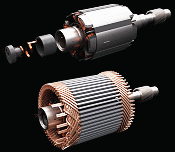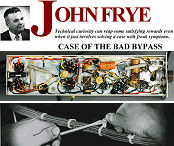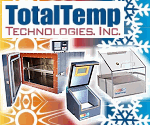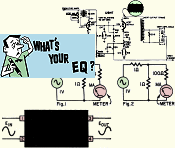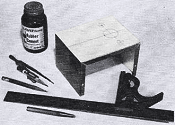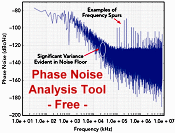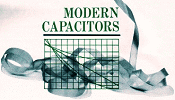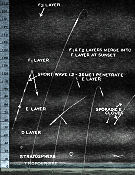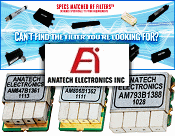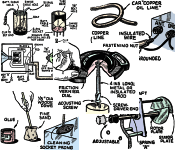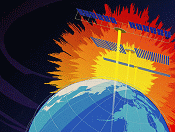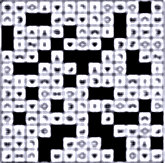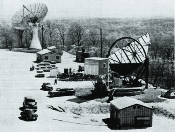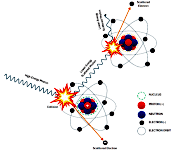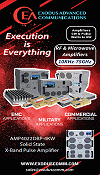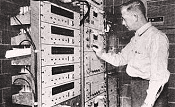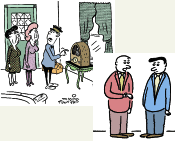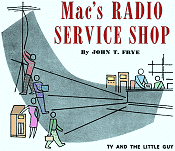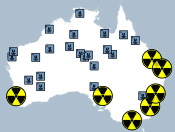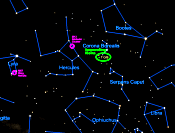 These three
electronics-themed comics appeared in the February 1953 issue of
Radio-Electronics magazine. The first one showing the television repairman employing
contortionist technique in order to tweak the picture is pretty good. I have seen
an advertisement in one of these magazines offering a deflection coil alignment
signal generator box that had a mirror mounted inside the cover specifically for
doing the job that tech is doing in the comic. Another comic no doubt hit home with
in-home servicemen of the day; at least the owner was honest. The other plays off
a brand of humor common in the day that demonstrated the public's fascination with
all the newfangled technology showing up every day...
These three
electronics-themed comics appeared in the February 1953 issue of
Radio-Electronics magazine. The first one showing the television repairman employing
contortionist technique in order to tweak the picture is pretty good. I have seen
an advertisement in one of these magazines offering a deflection coil alignment
signal generator box that had a mirror mounted inside the cover specifically for
doing the job that tech is doing in the comic. Another comic no doubt hit home with
in-home servicemen of the day; at least the owner was honest. The other plays off
a brand of humor common in the day that demonstrated the public's fascination with
all the newfangled technology showing up every day...
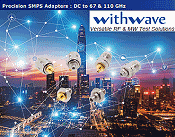 Withwave is a leading designer and
developer of a broad range of RF, microwave, and millimeter-wave test solutions
and subsystems with a focus on electromagnetic field analysis and signal
processing. Withwave's s
Precision SMPS Adapters are between-series types designed based on precision
microwave interconnection technologies for materials and machining. These
precision microwave connector interfaces ensure excellent performance up to 67 &
110 GHz, over a temperature range of -65 to +165° C. Typical VSWR is DC to 67 GHz: 1.30:1, DC to 100 GHz: 1.50:1, and DC to 110 GHz: 1.80:1...
Withwave is a leading designer and
developer of a broad range of RF, microwave, and millimeter-wave test solutions
and subsystems with a focus on electromagnetic field analysis and signal
processing. Withwave's s
Precision SMPS Adapters are between-series types designed based on precision
microwave interconnection technologies for materials and machining. These
precision microwave connector interfaces ensure excellent performance up to 67 &
110 GHz, over a temperature range of -65 to +165° C. Typical VSWR is DC to 67 GHz: 1.30:1, DC to 100 GHz: 1.50:1, and DC to 110 GHz: 1.80:1...
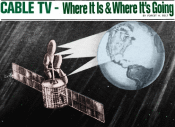 According to this 1972 article in
Popular Electronics magazine,
cable television began around 1950. The system was very different that what we
have nearly 70 years later. The familiar acronym CATV does not stand for CAble
TeleVision, but rather
Community Access TeleVision. CATV, as originally implemented, was a means of
bringing broadcast TV to areas either too remote or too shielded from
over-the-air (OTA) RF signals to provide good signal reception. Depending on the
need, CATV could range from re-broadcasting of signals into targeted areas or
sending signals through cable (originally unshielded) to individual homes...
According to this 1972 article in
Popular Electronics magazine,
cable television began around 1950. The system was very different that what we
have nearly 70 years later. The familiar acronym CATV does not stand for CAble
TeleVision, but rather
Community Access TeleVision. CATV, as originally implemented, was a means of
bringing broadcast TV to areas either too remote or too shielded from
over-the-air (OTA) RF signals to provide good signal reception. Depending on the
need, CATV could range from re-broadcasting of signals into targeted areas or
sending signals through cable (originally unshielded) to individual homes...
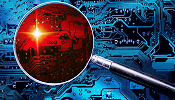 The semiconductor industry's technological
advances make it a prime target for espionage, facilitating protective measures
and design strategies to protect intellectual property. While the semiconductor
industry continues to become more lucrative, with revenue projected to increase
to $630 billion in 2024, it's also a prime target for
espionage and theft. Several trends are influencing the espionage landscape,
including an increased focus on cyber and economic espionage and state-sponsored
activities. Cyberattacks, hacking, and other sophisticated techniques have also
evolved and become more prevalent. For instance, the U.S. government continues to
uphold a ban on importing and exporting artificial-intelligence (AI) chips to China...
The semiconductor industry's technological
advances make it a prime target for espionage, facilitating protective measures
and design strategies to protect intellectual property. While the semiconductor
industry continues to become more lucrative, with revenue projected to increase
to $630 billion in 2024, it's also a prime target for
espionage and theft. Several trends are influencing the espionage landscape,
including an increased focus on cyber and economic espionage and state-sponsored
activities. Cyberattacks, hacking, and other sophisticated techniques have also
evolved and become more prevalent. For instance, the U.S. government continues to
uphold a ban on importing and exporting artificial-intelligence (AI) chips to China...
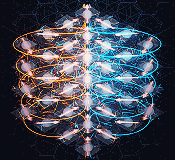 Researchers discovered that nickel iodide
exhibits exceptional
magnetoelectric coupling, making it highly suitable for use in high-speed and
energy-efficient technologies such as magnetic memories and quantum computing. The
layered multiferroic material nickel iodide may be the best candidate yet for devices
such as magnetic computer memory that are extremely fast and compact. Multiferroics
and Nickel Iodide For decades, scientists have been studying a group of unusual
materials called multiferroics that could be useful for a range of applications
including computer memory, chemical sensors and quantum computers. In a study published
in Nature, researchers from The University of Texas at Austin and the Max...
Researchers discovered that nickel iodide
exhibits exceptional
magnetoelectric coupling, making it highly suitable for use in high-speed and
energy-efficient technologies such as magnetic memories and quantum computing. The
layered multiferroic material nickel iodide may be the best candidate yet for devices
such as magnetic computer memory that are extremely fast and compact. Multiferroics
and Nickel Iodide For decades, scientists have been studying a group of unusual
materials called multiferroics that could be useful for a range of applications
including computer memory, chemical sensors and quantum computers. In a study published
in Nature, researchers from The University of Texas at Austin and the Max...
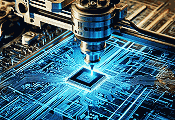 Researchers have developed a novel technique
for nanofabrication within silicon that allows for the creation of buried nanostructures
with feature sizes down to 100 nm. By utilizing spatially-modulated laser pulses,
they have achieved unprecedented control and precision in creating
nanophotonic elements, offering significant potential for advancements in electronics
and photonics. A new method enables precise nanofabrication inside silicon using
spatial light modulation and laser pulses, creating advanced nanostructures for
potential use in electronics...
Researchers have developed a novel technique
for nanofabrication within silicon that allows for the creation of buried nanostructures
with feature sizes down to 100 nm. By utilizing spatially-modulated laser pulses,
they have achieved unprecedented control and precision in creating
nanophotonic elements, offering significant potential for advancements in electronics
and photonics. A new method enables precise nanofabrication inside silicon using
spatial light modulation and laser pulses, creating advanced nanostructures for
potential use in electronics...
 Banner Ads are rotated in all locations
on the page! RF Cafe typically receives 8,000-15,000 visits each
weekday. RF Cafe
is a favorite of engineers, technicians, hobbyists, and students all over the world.
With more than 17,000 pages in the Google search index, RF Cafe returns in
favorable positions on many types of key searches, both for text and images.
Your Banner Ads are displayed on average0,000 times per year! New content
is added on a daily basis, which keeps the major search engines interested enough
to spider it multiple times each day. Items added on the homepage often can be found
in a Google search within a few hours of being posted. If you need your company
news to be seen, RF Cafe is the place to be...
Banner Ads are rotated in all locations
on the page! RF Cafe typically receives 8,000-15,000 visits each
weekday. RF Cafe
is a favorite of engineers, technicians, hobbyists, and students all over the world.
With more than 17,000 pages in the Google search index, RF Cafe returns in
favorable positions on many types of key searches, both for text and images.
Your Banner Ads are displayed on average0,000 times per year! New content
is added on a daily basis, which keeps the major search engines interested enough
to spider it multiple times each day. Items added on the homepage often can be found
in a Google search within a few hours of being posted. If you need your company
news to be seen, RF Cafe is the place to be...
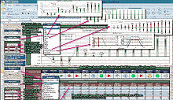 RF Cascade Workbook is the next phase in the evolution of RF Cafe's long-running
series, RF Cascade Workbook. Chances are you have never used a spreadsheet
quite like this (click
here for screen capture). It is a full-featured RF system cascade parameter
and frequency planner that includes filters and mixers for a mere $45. Built in
MS Excel, using RF Cascade Workbook is a cinch and the format
is entirely customizable. It is significantly easier and faster than using a multi-thousand
dollar simulator when a high level system analysis is all that is needed...
RF Cascade Workbook is the next phase in the evolution of RF Cafe's long-running
series, RF Cascade Workbook. Chances are you have never used a spreadsheet
quite like this (click
here for screen capture). It is a full-featured RF system cascade parameter
and frequency planner that includes filters and mixers for a mere $45. Built in
MS Excel, using RF Cascade Workbook is a cinch and the format
is entirely customizable. It is significantly easier and faster than using a multi-thousand
dollar simulator when a high level system analysis is all that is needed...
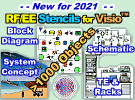 With more than 1000
custom-built stencils, this has got to be the most comprehensive set of
Visio Stencils
available for RF, analog, and digital system and schematic drawings! Every stencil
symbol has been built to fit proportionally on the included A-, B-, and C-size drawing
page templates (or use your own page if preferred). Components are provided for
system block diagrams, conceptual drawings, schematics, test equipment, racks, and
more. Page templates are provided with a preset scale (changeable) for a good presentation
that can incorporate all provided symbols...
With more than 1000
custom-built stencils, this has got to be the most comprehensive set of
Visio Stencils
available for RF, analog, and digital system and schematic drawings! Every stencil
symbol has been built to fit proportionally on the included A-, B-, and C-size drawing
page templates (or use your own page if preferred). Components are provided for
system block diagrams, conceptual drawings, schematics, test equipment, racks, and
more. Page templates are provided with a preset scale (changeable) for a good presentation
that can incorporate all provided symbols...
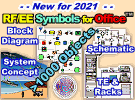 It was a lot of work, but I finally finished
a version of the "RF &
Electronics Schematic & Block Diagram Symbols"" that works well with Microsoft
Office™ programs Word™, Excel™, and Power Point™. This is an equivalent of the extensive
set of amplifier, mixer, filter, switch, connector, waveguide, digital, analog,
antenna, and other commonly used symbols for system block diagrams and schematics
created for Visio™. Each of the 1,000+ symbols was exported individually from Visio
in the EMF file format, then imported into Word on a Drawing Canvas. The EMF format
allows an image to be scaled up or down without becoming pixelated, so all the shapes
can be resized in a document and still look good. The imported symbols can also
be UnGrouped into their original constituent parts for editing...
It was a lot of work, but I finally finished
a version of the "RF &
Electronics Schematic & Block Diagram Symbols"" that works well with Microsoft
Office™ programs Word™, Excel™, and Power Point™. This is an equivalent of the extensive
set of amplifier, mixer, filter, switch, connector, waveguide, digital, analog,
antenna, and other commonly used symbols for system block diagrams and schematics
created for Visio™. Each of the 1,000+ symbols was exported individually from Visio
in the EMF file format, then imported into Word on a Drawing Canvas. The EMF format
allows an image to be scaled up or down without becoming pixelated, so all the shapes
can be resized in a document and still look good. The imported symbols can also
be UnGrouped into their original constituent parts for editing...
 With more than 1000
custom-built symbols, this has got to be the most comprehensive set of
Visio Symbols
available for RF, analog, and digital system and schematic drawings! Every object
has been built to fit proportionally on the provided A-, B- and C-size drawing page
templates (or can use your own). Symbols are provided for equipment racks and test
equipment, system block diagrams, conceptual drawings, and schematics. Unlike previous
versions, these are NOT Stencils, but instead are all contained on tabbed pages
within a single Visio document. That puts everything in front of you in its full
glory. Just copy and paste what you need on your drawing...
With more than 1000
custom-built symbols, this has got to be the most comprehensive set of
Visio Symbols
available for RF, analog, and digital system and schematic drawings! Every object
has been built to fit proportionally on the provided A-, B- and C-size drawing page
templates (or can use your own). Symbols are provided for equipment racks and test
equipment, system block diagrams, conceptual drawings, and schematics. Unlike previous
versions, these are NOT Stencils, but instead are all contained on tabbed pages
within a single Visio document. That puts everything in front of you in its full
glory. Just copy and paste what you need on your drawing...
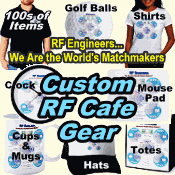 This assortment of custom-designed themes
by RF Cafe includes T-Shirts, Mouse Pads, Clocks, Tote Bags, Coffee Mugs and Steins,
Purses, Sweatshirts, Baseball Caps, and more, all sporting my amazingly clever "RF Engineers - We Are the World's Matchmakers"
Smith chart design. These would make excellent gifts for husbands, wives, kids,
significant others, and for handing out at company events or as rewards for excellent
service. My graphic has been ripped off by other people and used on their products,
so please be sure to purchase only official RF Cafe gear. I only make a couple bucks
on each sale - the rest goes to Cafe Press. It's a great way to help support RF
Cafe. Thanks...
This assortment of custom-designed themes
by RF Cafe includes T-Shirts, Mouse Pads, Clocks, Tote Bags, Coffee Mugs and Steins,
Purses, Sweatshirts, Baseball Caps, and more, all sporting my amazingly clever "RF Engineers - We Are the World's Matchmakers"
Smith chart design. These would make excellent gifts for husbands, wives, kids,
significant others, and for handing out at company events or as rewards for excellent
service. My graphic has been ripped off by other people and used on their products,
so please be sure to purchase only official RF Cafe gear. I only make a couple bucks
on each sale - the rest goes to Cafe Press. It's a great way to help support RF
Cafe. Thanks...
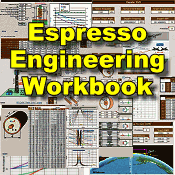 The newest release of RF Cafe's spreadsheet
(Excel) based engineering and science calculator is now available -
Espresso Engineering Workbook™. Among other additions, it now has a Butterworth
Bandpass Calculator, and a Highpass Filter Calculator that does not just gain, but
also phase and group delay! Since 2002,
the original Calculator Workbook has been available as a free download.
Continuing the tradition, RF Cafe Espresso Engineering Workbook™ is
also provided at no cost,
compliments of my generous sponsors. The original calculators are included, but
with a vastly expanded and improved user interface. Error-trapped user input cells
help prevent entry of invalid values. An extensive use of Visual Basic for Applications
(VBA) functions now do most of the heavy lifting with calculations, and facilitates
a wide user-selectable choice of units for voltage, frequency, speed, temperature,
power, wavelength, weight, etc. In fact, a full page of units conversion calculators
is included. A particularly handy feature is the ability to specify the the number
of significant digits to display. Drop-down menus are provided for convenience...
The newest release of RF Cafe's spreadsheet
(Excel) based engineering and science calculator is now available -
Espresso Engineering Workbook™. Among other additions, it now has a Butterworth
Bandpass Calculator, and a Highpass Filter Calculator that does not just gain, but
also phase and group delay! Since 2002,
the original Calculator Workbook has been available as a free download.
Continuing the tradition, RF Cafe Espresso Engineering Workbook™ is
also provided at no cost,
compliments of my generous sponsors. The original calculators are included, but
with a vastly expanded and improved user interface. Error-trapped user input cells
help prevent entry of invalid values. An extensive use of Visual Basic for Applications
(VBA) functions now do most of the heavy lifting with calculations, and facilitates
a wide user-selectable choice of units for voltage, frequency, speed, temperature,
power, wavelength, weight, etc. In fact, a full page of units conversion calculators
is included. A particularly handy feature is the ability to specify the the number
of significant digits to display. Drop-down menus are provided for convenience...
 One aspect of advertising on the RF Cafe
website I have not covered is using
Google AdSense.
The reason is that I never took the time to explore how - or even whether it is
possible - to target a specific website for displaying your banner ads. A couple
display opportunities have always been provided for Google Ads to display, but the
vast majority of advertising on RF Cafe is done via private advertisers. That is,
companies deal with me directly and I handle inserting their banner ads into the
html page code that randomly selects and displays them. My advertising scheme is
what the industry refers to as a "Tenancy Campaign," whereby a flat price per month
is paid regardless of number of impressions or clicks. It is the simplest format
and has seemed to work well for many companies. With nearly 4 million pageviews
per year for RFCafe.com, the average impression rate per banner ad is about0k per
year (in eight locations on each page, with >17k pages)...
One aspect of advertising on the RF Cafe
website I have not covered is using
Google AdSense.
The reason is that I never took the time to explore how - or even whether it is
possible - to target a specific website for displaying your banner ads. A couple
display opportunities have always been provided for Google Ads to display, but the
vast majority of advertising on RF Cafe is done via private advertisers. That is,
companies deal with me directly and I handle inserting their banner ads into the
html page code that randomly selects and displays them. My advertising scheme is
what the industry refers to as a "Tenancy Campaign," whereby a flat price per month
is paid regardless of number of impressions or clicks. It is the simplest format
and has seemed to work well for many companies. With nearly 4 million pageviews
per year for RFCafe.com, the average impression rate per banner ad is about0k per
year (in eight locations on each page, with >17k pages)...
June 1969 P-E, Kohler p45
August 1969, Hobnobbing Harbaugh p68
5/31/2024 Radio-Electronics June 1968 "20 Unijunction Transistor Applications
Part 1"
5/31/2024 Radio-Electronics June 1968 "Electronics-Themed Comics"
5/30/2024 Radio-Electronics September 1968 "News Briefs"
5/29/2024 Radio-Electronics September 1962 "Precision Apparatus Company Test
Equipment Ad"
5/27/2024 Radio-Electronics September 1962 "What's Your EQ?"
5/27/2024 Radio-Electronics September 1962 "Traffic Jam Ahead on Short Waves"
5/27/2024 Radio-Electronics September 1962 "Electronics-Themed Comics"
5/27/2024 Radio-Electronics September 1962 "Telstar - Giant Step into the Future"
5/27/2024 Radio-Electronics September 1962 "News Briefs"
5/27/2024 Radio-Electronics June 1967 "R-E Puzzler"
5/24/2024 Radio-Electronics June 1967 "News Briefs"
5/24/2024 Radio-Electronics June 1967 "Our Electronic Future"
5/24/2024 36 Radio-Electronics May 1967 "Comsat: Communication in the Space Age"
5/23/2024 Radio-Electronics May 1967 "What's Your EQ?"
5/23/2024 Radio-Electronics May 1967 "World's Toughest R/C Job - Guidance in
Outer Space"
5/22/2024 Radio-Electronics May 1967 "News Briefs"
5/22/2024 Radio-Electronics May 1967 "R-E Puzzler"
5/22/2024 Radio-Electronics May 1967 "Imaginary Numbers Are a Cinch - Part 1"
5/20/2024 Radio-Electronics January 1968 "Imaginary Numbers Are a Cinch - Part
2"
5/20/2024 Radio-Electronics December 1967 & January 1968 "Comics"
5/20/2024 Radio-Electronics December 1967 "Rotary Stepping Switches - They're
Everywhere"
5/16/2024 Radio-Electronics November 1967 "What You Should Know About X-Ray Radiation
in TV Sets"
5/7/2024 Radio-Electronics November 1967 "Rotary Stepping Switches - They're
Everywhere"
5/7/2024 Radio-Electronics November 1967 "Hugo Gernsback Obituary"
5/7/2024 Radio-Electronics July 1962 "Our Patent Problem - A Proposed Solution"
5/3/2024 Radio-Electronics July 1962 "Electronics-Themed Comics"
5/3/2024 Radio-Electronics July 1962 "Mallory - Tips for Technicians" Ready 5/3/2024
Radio-Electronics July 1962 "News Briefs"
5/1/2024 Radio-Electronics July 1962 "What's Your EQ?"
5/1/2024 Radio-Electronics July1962 "Handling the Metric Prefixes"
5/1/2024 Radio-Electronics August 1962 "Bell Telephone Laboratories"
5/1/2024 Radio-Electronics August 1962 "News Briefs"
5/1/2024 Radio-Electronics August 1962 "Can You Name These Strange Electronic
Effects?"
5/1/2024 Radio-Electronics August 1962 "Electronic Navigation in Flight"
5/1/2024 Radio-Electronics August 1962 "Electronics-Themed Comics"
5/1/2024 Radio-Electronics January 1962 "Electronics-Themed Comics"
4/30/2024 Radio-Electronics January 1962 "Amphenol Polyfoam® Coaxial Cable"
4/30/2024 Radio-Electronics January 1962 "News Briefs"
4/30/2024 Radio-Electronics January 1962 "Seeing is Believing in Cathode Research"
4/30/2024 Radio-Electronics January 1962 "Electronic Cooling & Heating"
4/29/2024 Radio-Electronics January 1962 "Future of Service Industry"
4/26/2024 Radio-Electronics January 1962 "What's Your EQ?"
4/26/2024 Radio-Electronics February 1962 "Electronics-Themed Comics"
4/25/2024 Radio-Electronics February 1962 "News Briefs"
4/25/2024 Radio-Electronics February 1962 "Bell Telephone Laboratories Ad"
4/25/2024 Radio-Electronics February 1962 "FM Antennas for Better Listening"
4/25/2024 Radio-Electronics February 1962 "What's Your EQ?"
4/17/2024 Radio-Electronics March 1962 "What's Your EQ?"
4/17/2024 Radio-Electronics March 1962 "Electronics-Themed Comics"
4/17/2024 Radio-Electronics March 1962 "News Briefs"
4/17/2024 Radio-Electronics March 1962 "Electronic Careers in the Navy"
4/16/2024 Radio-Electronics March 1962 "Unexplored Electron Gap"
4/16/2024 Additional Text for Radio-Electronics June 1961 "What's Your EQ?"
4/16/2024 Radio-Electronics July 1961 "News Briefs"
4/16/2024 Radio-Electronics July 1961 "RCA Electron Gun"
4/16/2024 Radio-Electronics July 1961 "Comics"
4/16/2024 Radio-Electronics July 1961 "Clear Road for FM Stereo"
4/16/2024 Radio-Electronics July 1961 "Radio Power"
4/15/2024 Radio-Electronics July 1961 "What's Your EQ?"
4/15/2024 Radio-Electronics August 1961 "News Briefs"
4/12/2024 Radio-Electronics August 1961 "Electronics-Themed Comics"
4/12/2024 Radio-Electronics September 1961 "Howard W. Sams & Co. Photofact
Ad"
4/9/2024 Radio-Electronics August 1961 "What's Your EQ?"
4/9/2024 Radio-Electronics September 1961 "Electronics-Themed Comics"
4/9/2024 Radio-Electronics September 1961 "News Briefs"
4/9/2024 Radio-Electronics September 1961 "What Did de Forest Really Invent?"
4/9/2024 Radio-Electronics September 1961 "D. Van Nostrand Company International
Dictionary of Physics and Electronics"
4/5/2024 Radio-Electronics September 1961 "What's Your EQ?"
4/4/2024 Radio-Electronics October 1961 "Universal Replacement Parts Kit from
Standard Kollsman Industries"
4/4/2024 Radio-Electronics October 1961 "Electronics-Themed Comics"
4/4/2024 Radio-Electronics October 1961 "Sporadic-E Opens New Horizons"
4/3/2024 Radio-Electronics October 1961 "Radio Shack Realistic Kits Ad"
4/3/2024 Radio-Electronics October 1961 "Bell Telephone Laboratories Ad"
4/3/2024 Radio-Electronics October 1961 "News Briefs"
4/3/2024 Radio-Electronics October 1961 "What's Your EQ?"
4/3/2024 Radio-Electronics November 1961 "Howard W. Sams Photofact Ad"
4/2/2024 Radio-Electronics November 1961 "News Briefs"
4/2/2024 Radio-Electronics November 1961 "New Link in US Defense - Pacific Scatter"
4/1/2024 Radio-Electronics September 1960 "Magic Carpet Antenna Ad"
3/28/2024 Radio-Electronics September 1960 "News Briefs"
3/28/2024 Radio-Electronics September 1960 "Electronics-Themed Comics"
3/28/2024 Radio-Electronics October 1960 "Electronics-Themed Comics"







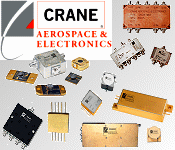
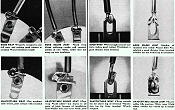
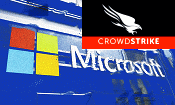
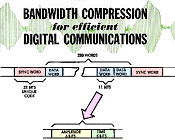 Bandwidth compression
Bandwidth compression